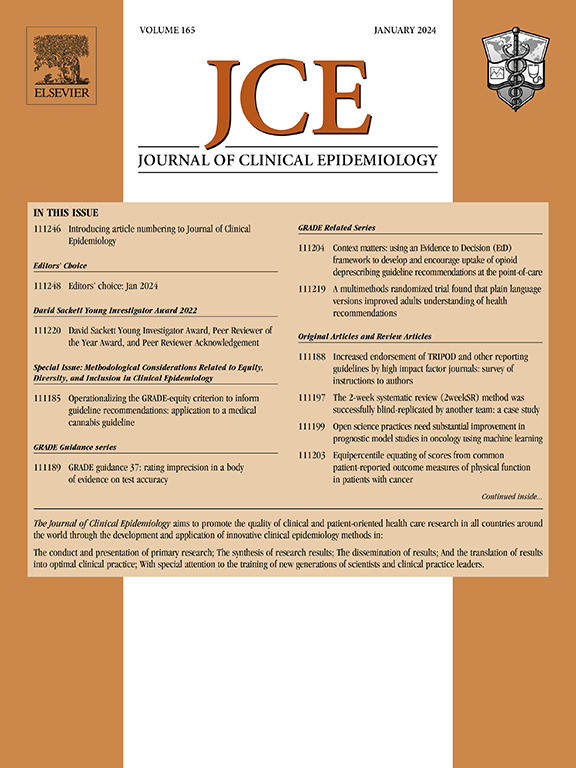EORTC qu - c10d与EQ-5D-5L同样有效和敏感,但对癌症患者健康恶化的反应更灵敏。
IF 5.2
2区 医学
Q1 HEALTH CARE SCIENCES & SERVICES
引用次数: 0
摘要
目的:生活质量实用核心10维度(QLU-C10D)是最近开发的一种针对癌症患者的疾病特异性偏好测量(PBM),其心理测量性能尚未得到很好的理解。本研究旨在比较qu - c10d与EQ-5D-5L(一种通用PBM)的构念效度、敏感性和反应性。研究设计和设置:我们从一家三级肿瘤医院门诊招募癌症患者,并在连续两次就诊时使用QLU-C10D和EQ-5D-5L问卷进行面对面访谈。通过已知组比较和相关分析评估结构效度,使用类内相关系数(ICC)检查效用得分的一致性,分别使用已知组比较的效应量(ES)和组内比较的标准化反应均值(SRM)来比较敏感性和反应性。结果:共调查626例患者,其中280例完成了随访调查。平均基线qu - c10d和EQ-5D-5L效用评分分别为0.799 (SD: 0.224)和0.916 (SD: 0.156)。两种效用得分均表现出已知组效度和收敛/区别效度,一致性为中等(ICC: 0.60)。EQ-5D-5L分期ES略高于QLU-C10D,东部肿瘤组(ECOG) QLU-C10D分期ES高于QLU-C10D。qu - c10d在恶化患者的SRM显著高于EQ-5D-5L (-0.43 vs. -0.02),而改善患者的SRM相似。结论:虽然QLU-C10D和EQ-5D-5L效用评分在癌症患者中都是有效的,但它们可能不能互换使用,QLU-C10D评分似乎比eq - 5d - 5l评分更能反映健康状况的恶化。本文章由计算机程序翻译,如有差异,请以英文原文为准。
EORTC QLU-C10D was similarly valid and sensitive as EQ-5D-5L but more responsive to cancer patients' health deterioration
Objectives
The psychometric performance of the Quality of Life Utility-Core 10 Dimensions (QLU-C10D), a recently developed disease-specific preference-based measure (PBM) for patients with cancer, is not well understood yet. This study aimed to compare the construct validity, sensitivity, and responsiveness of QLU-C10D with that of 5-level EQ-5D (EQ-5D-5L), a generic PBM.
Study Design and Setting
We recruited patients with cancer from outpatient clinics of a tertiary cancer hospital then interviewed them face-to-face at two consecutive clinic visits using both QLU-C10D and EQ-5D-5L questionnaires. Construct validity was assessed through known-group comparisons and correlation analysis, agreement of utility scores was examined using intraclass correlation coefficient (ICC), and sensitivity and responsiveness compared using effect sizes (ESs) derived from known-group comparisons and standardized response means (SRMs) derived from within-group comparisons, respectively.
Results
We surveyed 626 patients; 280 of whom also completed the follow-up survey. Mean baseline QLU-C10D and EQ-5D-5L utility scores were 0.799 (SD: 0.224) and 0.916 (SD: 0.156), respectively. Both utility scores demonstrated known-groups and convergent/discriminant validity and their agreement was moderate (ICC: 0.60). EQ-5D-5L's ES was slightly higher than QLU-C10D's ES for cancer stage, whereas QLU-C10D's ES was higher for Eastern Cooperative Oncology Group. The SRM of QLU-C10D was considerably higher than that of EQ-5D-5L for deteriorated patients (−0.43 vs −0.02), whereas their SRMs were similar for the improved patients.
Conclusion
Although QLU-C10D and EQ-5D-5L utility scores are both valid in patients with cancer, they may not be used interchangeably, and the QLU-C10D scores appear to be more responsive to deterioration in health status than the EQ-5D-5Lscores.
求助全文
通过发布文献求助,成功后即可免费获取论文全文。
去求助
来源期刊

Journal of Clinical Epidemiology
医学-公共卫生、环境卫生与职业卫生
CiteScore
12.00
自引率
6.90%
发文量
320
审稿时长
44 days
期刊介绍:
The Journal of Clinical Epidemiology strives to enhance the quality of clinical and patient-oriented healthcare research by advancing and applying innovative methods in conducting, presenting, synthesizing, disseminating, and translating research results into optimal clinical practice. Special emphasis is placed on training new generations of scientists and clinical practice leaders.
 求助内容:
求助内容: 应助结果提醒方式:
应助结果提醒方式:


